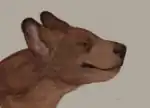| Monroe Creek Formation | |
|---|---|
| Stratigraphic range: Paleogene | |
| Type | Geological formation |
| Location | |
| Region | |
| Country | |
The Monroe Creek Formation is a geologic formation in South Dakota. It preserves fossils dating back to the Paleogene period.
Fossil content
Color key
|
Notes Uncertain or tentative taxa are in small text; |
Mammals
Carnivorans
| Carnivorans reported from the Monroe Creek Formation | |||||
|---|---|---|---|---|---|
| Genus | Species | Presence | Material | Notes | Images |
| Enhydrocyon | E. crassidens | Shannon County, South Dakota.[1] | Crushed skull (AMNH 12886) & other skull elements.[1][2] | A hesperocyonine dog. | _fig._6.png.webp) |
| E. pahinsintewakpa | Multiple specimens.[1] | A hesperocyonine dog. |  | ||
| Leptocyon | L. delicatus | Porcupine Creek, South Dakota.[2][3] | Left partial ramus (ACM 31102).[2][3] | A canine dog, may instead be from the Harrison Formation. |  |
| Mammacyon | M. obtusidens | Wounded Knee Area.[2] | Skull & partial skeleton (ACM 34-41).[2] | A bear-dog. | |
| Neocynodesmus | N. delicatus | Porcupine Creek, Wounded Knee Area.[2] | Left mandible (ACM 31102).[2] | Junior synonym of Leptocyon. | |
| Nimravus | N. sectator | Wounded Knee Area.[2] | Left ramus (AMNH 12882).[2] | Possibly instead from the Harrison Formation. | |
| Nothocyon | N. geismarianus | Wounded Knee Area.[2] | Fragmentary ramus (AMNH 12872).[2] | An arctoid formerly thought to be a canid. | |
| N. near latidens | Wounded Knee Area.[2] | Jaw fragment (AMNH 12873).[2] | Reassigned to Phlaocyon. | ||
| Promartes | P. gemmarosae | Wounded Knee Area.[2] | Nearly-complete skeleton (ACM 31-33).[2] | A mustelid. | |
Eulipotyphlans
| Eulipotyphlans reported from the Monroe Creek Formation | |||||
|---|---|---|---|---|---|
| Genus | Species | Presence | Material | Notes | Images |
| Proscalops | P. sp. indeterminate | Wounded Knee Area.[2] | Isolated molar (SDSM 5899).[2] | A proscalopid. | |
Rodents
| Rodents reported from the Monroe Creek Formation | |||||
|---|---|---|---|---|---|
| Genus | Species | Presence | Material | Notes | Images |
| Allomys | A. harkseni | Wounded Knee Area.[2] | Molars.[2] | An aplodontid. | |
| Capatanka | C. brachyceps | Wounded Knee Area.[2] | Skull (AMNH 12902).[2] | A castorid, possibly instead from the Harrison Formation. | |
| Meniscomys | M. sp. indeterminate | Wounded Knee Area.[2] | Isolated tooth (SDSM 59157).[2] | An aplodontid. | |
| Palaeocastor | P. simplicidens | Wounded Knee Area.[2] | Partial cranium (AMNH 12900).[2] | A castorid. | |
| Pleurolicus | P. dakotensis | Wounded Knee Area.[2] | Left ramus (AMNH 12893).[2] | A gopher. | |
| Promylagaulus | P. cf. riggsi | Wounded Knee Area.[2] | Isolated molar.[2] | A mylagaulid. | |
Ungulates
| Ungulates reported from the Monroe Creek Formation | |||||
|---|---|---|---|---|---|
| Genus | Species | Presence | Material | Notes | Images |
| Nanotragulus | N. ordinatus | Wounded Knee Area.[2] | Mandibles.[2] | May instead be from the Harrison Formation. | |
| Parahippus | P. pristinus | Wounded Knee Area.[2] | Hind feet (AMNH 12922).[2] | May instead be from the Harrison Formation. | |
Reptiles
Squamates
| Squamates reported from the Monroe Creek Formation | |||||
|---|---|---|---|---|---|
| Genus | Species | Presence | Material | Notes | Images |
| Peltosaurus | P. granulosus | Sharps Corner, South Dakota.[4] | Multiple specimens.[4] | A glyptosaurine also known from the Sharps Formation. |  |
See also
References
- 1 2 3 Wang, Xiaoming (1994). "Phylogenetic systematics of the Hesperocyoninae (Carnivora, Canidae)". Bulletin of the AMNH (221): 6–207.
- 1 2 3 4 5 6 7 8 9 10 11 12 13 14 15 16 17 18 19 20 21 22 23 24 25 26 27 28 29 30 31 32 33 Macdonald, J. R. (James Reid); Thomson, Albert Report of the expedition of 1906 to the Miocene on Pine Ridge Indian Reservation (1963). "The Miocene faunas from the Wounded Knee area of western South Dakota. Bulletin of the AMNH ; v. 125, article 3".
{{cite journal}}: Cite journal requires|journal=(help)CS1 maint: numeric names: authors list (link) - 1 2 Tedford, Richard H.; Wang, Xiaoming; Taylor, Beryl E. (2009). Phylogenetic systematics of the North American fossil Caninae (Carnivora, Canidae). (Bulletin of the American Museum of Natural History, no. 325). [New York] : American Museum of Natural History.
- 1 2 Scarpetta, Simon G. (October 2019). "Peltosaurus granulosus (Squamata, Anguidae) from the Middle Oligocene of Sharps Corner, South Dakota, and the Youngest Known Chronostratigraphic Occurrence of Glyptosaurinae". Journal of Vertebrate Paleontology. 39 (3). doi:10.1080/02724634.2019.1622129. ISSN 0272-4634.
- Various Contributors to the Paleobiology Database. "Fossilworks: Gateway to the Paleobiology Database". Retrieved 17 December 2021.
This article is issued from Wikipedia. The text is licensed under Creative Commons - Attribution - Sharealike. Additional terms may apply for the media files.